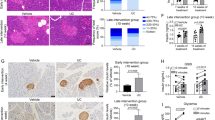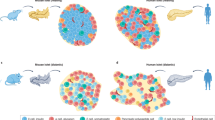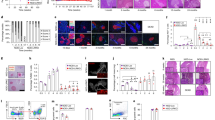Abstract
Type 1 diabetes (T1DM) is an autoimmune condition in which the immune system attacks and destroys insulin-producing beta cells in the pancreas leading to hyperglycemia. Vasoactive intestinal peptide (VIP) manifests insulinotropic and anti-inflammatory properties, which are useful for the treatment of diabetes. Because of its limited half-life due to DPP-4-mediated degradation, constant infusions or multiple injections are needed to observe any therapeutic benefit. Since gene therapy has the potential to treat genetic diseases, an HIV-based lentiviral vector carrying VIP gene (LentiVIP) was generated to provide a stable VIP gene expression in vivo. The therapeutic efficacy of LentiVIP was tested in a multiple low-dose STZ-induced animal model of T1DM. LentiVIP delivery into diabetic animals reduced hyperglycemia, improved glucose tolerance, and prevented weight loss. Also, a decrease in serum CRP levels, and serum oxidant capacity, but an increase in antioxidant capacity were observed in LentiVIP-treated animals. Restoration of islet cell mass was correlated with an increase in pancreatic beta-cell proliferation. These beneficial results suggest the therapeutic effect of LentiVIP is due to the repression of diabetes-induced inflammation, its insulinotropic properties, and VIP-induced beta-cell proliferation.
This is a preview of subscription content, access via your institution
Access options
Subscribe to this journal
Receive 12 print issues and online access
$259.00 per year
only $21.58 per issue
Buy this article
- Purchase on Springer Link
- Instant access to full article PDF
Prices may be subject to local taxes which are calculated during checkout







Similar content being viewed by others
References
Michels A, Zhang L, Khadra A, Kushner JA, Redondo MJ, Pietropaolo M. Prediction and prevention of type 1 diabetes: update on success of prediction and struggles at prevention. Pediatr Diabetes. 2015;16:465–84.
Krzewska A, Ben-Skowronek I. Effect of associated autoimmune diseases on type 1 diabetes mellitus incidence and metabolic control in children and adolescents. Biomed Res Int. 2016;2016:6219730.
Cerna M. Epigenetic regulation in etiology of type 1 diabetes mellitus. Int J Mol Sci. 2019;21:1–17.
Lee HS, Hwang JS. Genetic aspects of type 1 diabetes. Ann Pediatr Endocrinol Metab. 2019;24:143–8.
DiMeglio LA, Evans-Molina C, Oram RA. Type 1 diabetes. Lancet. 2018;391:2449–62.
Padgett LE, Broniowska KA, Hansen PA, Corbett JA, Tse HM. The role of reactive oxygen species and proinflammatory cytokines in type 1 diabetes pathogenesis. Ann N Y Acad Sci. 2013;1281:16–35.
Lu J, Liu J, Li L, Lan Y, Liang Y. Cytokines in type 1 diabetes: mechanisms of action and immunotherapeutic targets. Clin Transl Immunology. 2020;9:e1122.
Nepom GT, Ehlers M, Mandrup-Poulsen T. Anti-cytokine therapies in T1D: concepts and strategies. Clin Immunol. 2013;149:279–85.
Mastrandrea L, Yu J, Behrens T, Buchlis J, Albini C, Fourtner S, et al. Etanercept treatment in children with new-onset type 1 diabetes: pilot randomized, placebo-controlled, double-blind study. Diabetes Care. 2009;32:1244–9.
Rosenzwajg M, Churlaud G, Mallone R, Six A, Derian N, Chaara W, et al. Low-dose interleukin-2 fosters a dose-dependent regulatory T cell tuned milieu in T1D patients. J Autoimmun. 2015;58:48–58.
Sanlioglu AD, Karacay B, Balci MK, Griffith TS, Sanlioglu S. Therapeutic potential of VIP vs PACAP in diabetes. J Mol Endocrinol. 2012;49:R157–67.
Sragovich S, Amram N, Yeheskel A, Gozes I. VIP/PACAP-based drug development: the ADNP/NAP-derived mirror peptides SKIP and D-SKIP exhibit distinctive in vivo and in silico effects. Front Cell Neurosci. 2019;13:589.
Hannibal J, Fahrenkrug J. Pituitary adenylate cyclase-activating polypeptide in intrinsic and extrinsic nerves of the rat pancreas. Cell Tissue Res. 2000;299:59–70.
Yada T, Sakurada M, Ishihara H, Nakata M, Shioda S, Yaekura K, et al. Pituitary adenylate cyclase-activating polypeptide (PACAP) is an islet substance serving as an intra-islet amplifier of glucose-induced insulin secretion in rats. J Physiol. 1997;505:319–28.
Ganea D, Hooper KM, Kong W. The neuropeptide vasoactive intestinal peptide: direct effects on immune cells and involvement in inflammatory and autoimmune diseases. Acta Physiol (Oxf). 2015;213:442–52.
Martinez C, Juarranz Y, Gutierrez-Canas I, Carrion M, Perez-Garcia S, Villanueva-Romero R, et al. A clinical approach for the use of VIP axis in inflammatory and autoimmune diseases. Int J Mol Sci. 2019;21:1–44.
Lodde BM, Delporte C, Goldsmith CM, Tak PP, Baum BJ. A recombinant adenoviral vector encoding functional vasoactive intestinal peptide. Biochem Biophys Res Commun. 2004;319:189–92.
Lodde BM, Mineshiba F, Wang J, Cotrim AP, Afione S, Tak PP, et al. Effect of human vasoactive intestinal peptide gene transfer in a murine model of Sjogren’s syndrome. Ann Rheum Dis. 2006;65:195–200.
Herrera JL, Fernandez-Montesinos R, Gonzalez-Rey E, Delgado M, Pozo D. Protective role for plasmid DNA-mediated VIP gene transfer in non-obese diabetic mice. Ann N Y Acad Sci. 2006;1070:337–41.
Zhou Y, Zhang CY, Duan JX, Li Q, Yang HH, Sun CC, et al. Vasoactive intestinal peptide suppresses the NLRP3 inflammasome activation in lipopolysaccharide-induced acute lung injury mice and macrophages. Biomed Pharmacother. 2020;121:109596.
Zhang YF, Zhang J, Sun CC, Tang CY, Sun GY, Luo WJ, et al. Vasoactive intestinal peptide inhibits the activation of murine fibroblasts and expression of interleukin 17 receptor C. Cell Biol Int. 2019;43:770–80.
Sun GY, Yang HH, Guan XX, Zhong WJ, Liu YP, Du MY, et al. Vasoactive intestinal peptide overexpression mediated by lentivirus attenuates lipopolysaccharide-induced acute lung injury in mice by inhibiting inflammation. Mol Immunol. 2018;97:8–15.
Tasyurek HM, Eksi YE, Sanlioglu AD, Altunbas HA, Balci MK, Griffith TS, et al. HIV-based lentivirus-mediated vasoactive intestinal peptide gene delivery protects against DIO animal model of Type 2 diabetes. Gene Ther. 2018;25:269–83.
Sanlioglu AD, Griffith TS, Omer A, Dirice E, Sari R, Altunbas HA, et al. Molecular mechanisms of death ligand-mediated immune modulation: a gene therapy model to prolong islet survival in type 1 diabetes. J Cell Biochem. 2008;104:710–20.
Sanlioglu AD, Altunbas HA, Balci MK, Griffith TS, Sanlioglu S. Clinical utility of insulin and insulin analogs. Islets. 2013;5:67–78.
Sanlioglu AD, Altunbas HA, Balci MK, Griffith TS, Sanlioglu S. Insulin gene therapy from design to beta cell generation. Expert Rev Mol Med. 2012;14:e18.
Tasyurek HM, Altunbas HA, Balci MK, Griffith TS, Sanlioglu S. Therapeutic potential of lentivirus-mediated glucagon-like peptide-1 gene therapy for diabetes. Hum Gene Ther. 2018;29:802–15.
Chen YG, Mathews CE, Driver JP. The role of NOD mice in type 1 diabetes research: lessons from the past and recommendations for the future. Front Endocrinol. 2018;9:51.
Dirice E, Kahraman S, Elpek GO, Aydin C, Balci MK, Omer A, et al. TRAIL and DcR1 expressions are differentially regulated in the pancreatic islets of STZ- versus CY-applied NOD mice. Exp Diabetes Res. 2011;2011:625813.
Rosignoli F, Torroba M, Juarranz Y, Garcia-Gomez M, Martinez C, Gomariz RP, et al. VIP and tolerance induction in autoimmunity. Ann N Y Acad Sci. 2006;1070:525–30.
Kahraman S, Aydin C, Elpek GO, Dirice E, Sanlioglu AD, Diabetes-resistant NOR. mice are more severely affected by streptozotocin compared to the diabetes-prone NOD mice: correlations with liver and kidney GLUT2 expressions. J Diabetes Res. 2015;2015:450128.
Roep BO, Atkinson M, von Herrath M. Satisfaction (not) guaranteed: re-evaluating the use of animal models of type 1 diabetes. Nat Rev Immunol. 2004;4:989–97.
Atkinson MA, Leiter EH. The NOD mouse model of type 1 diabetes: as good as it gets? Nat Med. 1999;5:601–4.
Tasyurek MH, Altunbas HA, Canatan H, Griffith TS, Sanlioglu S. GLP-1-mediated gene therapy approaches for diabetes treatment. Expert Rev Mol Med. 2014;16:e7.
Wang Z, Gleichmann H. GLUT2 in pancreatic islets: crucial target molecule in diabetes induced with multiple low doses of streptozotocin in mice. Diabetes. 1998;47:50–6.
Muller A, Schott-Ohly P, Dohle C, Gleichmann H. Differential regulation of Th1-type and Th2-type cytokine profiles in pancreatic islets of C57BL/6 and BALB/c mice by multiple low doses of streptozotocin. Immunobiology. 2002;205:35–50.
O’Brien BA, Harmon BV, Cameron DP, Allan DJ. Beta-cell apoptosis is responsible for the development of IDDM in the multiple low-dose streptozotocin model. J Pathol. 1996;178:176–81.
Li Z, Karlsson FA, Sandler S. Islet loss and alpha cell expansion in type 1 diabetes induced by multiple low-dose streptozotocin administration in mice. J Endocrinol. 2000;165:93–9.
Dirice E, Sanlioglu AD, Kahraman S, Ozturk S, Balci MK, Omer A, et al. Adenovirus-mediated TRAIL gene (Ad5hTRAIL) delivery into pancreatic islets prolongs normoglycemia in streptozotocin-induced diabetic rats. Hum Gene Ther. 2009;20:1177–89.
Akbarzadeh A, Norouzian D, Mehrabi MR, Jamshidi S, Farhangi A, Verdi AA, et al. Induction of diabetes by Streptozotocin in rats. Indian J Clin Biochem. 2007;22:60–4.
Gale EA. The discovery of type 1 diabetes. Diabetes. 2001;50:217–26.
In’t Veld P. Insulitis in human type 1 diabetes: The quest for an elusive lesion. Islets. 2011;3:131–8.
Cecil RL. A study of the pathological anatomy of the pancreas in ninety cases of diabetes mellitus. J Exp Med. 1909;11:266–90.
Doniach I, Morgan AG. Islets of Langerhans in juvenile diabetes mellitus. Clin Endocrinol. 1973;2:233–48.
Campbell-Thompson M, Fu A, Kaddis JS, Wasserfall C, Schatz DA, Pugliese A, et al. Insulitis and beta-cell mass in the natural history of type 1 diabetes. Diabetes. 2016;65:719–31.
Kato I, Suzuki Y, Akabane A, Yonekura H, Tanaka O, Kondo H, et al. Transgenic mice overexpressing human vasoactive intestinal peptide (VIP) gene in pancreatic beta cells. Evidence for improved glucose tolerance and enhanced insulin secretion by VIP and PHM-27 in vivo. J Biol Chem. 1994;269:21223–8.
Asnicar MA, Koster A, Heiman ML, Tinsley F, Smith DP, Galbreath E, et al. Vasoactive intestinal polypeptide/pituitary adenylate cyclase-activating peptide receptor 2 deficiency in mice results in growth retardation and increased basal metabolic rate. Endocrinology. 2002;143:3994–4006.
Hultgardh-Nilsson A, Nilsson J, Jonzon B, Dalsgaard CJ. Growth-inhibitory properties of vasoactive intestinal polypeptide. Regul Pept. 1988;22:267–74.
Maruno K, Absood A, Said SI. VIP inhibits basal and histamine-stimulated proliferation of human airway smooth muscle cells. Am J Physiol. 1995;268:L1047–51.
Martin B, Shin YK, White CM, Ji S, Kim W, Carlson OD, et al. Vasoactive intestinal peptide-null mice demonstrate enhanced sweet taste preference, dysglycemia, and reduced taste bud leptin receptor expression. Diabetes. 2010;59:1143–52.
Yamamoto K, Hashimoto H, Tomimoto S, Shintani N, Miyazaki J, Tashiro F, et al. Overexpression of PACAP in transgenic mouse pancreatic beta-cells enhances insulin secretion and ameliorates streptozotocin-induced diabetes. Diabetes. 2003;52:1155–62.
Edvell A, Lindstrom P. Initiation of increased pancreatic islet growth in young normoglycemic mice (Umea +/?). Endocrinology. 1999;140:778–83.
Yamamoto J, Imai J, Izumi T, Takahashi H, Kawana Y, Takahashi K, et al. Neuronal signals regulate obesity induced beta-cell proliferation by FoxM1 dependent mechanism. Nat Commun. 2017;8:1930.
Xu G, Stoffers DA, Habener JF, Bonner-Weir S. Exendin-4 stimulates both beta-cell replication and neogenesis, resulting in increased beta-cell mass and improved glucose tolerance in diabetic rats. Diabetes. 1999;48:2270–6.
Muriach M, Flores-Bellver M, Romero FJ, Barcia JM. Diabetes and the brain: oxidative stress, inflammation, and autophagy. Oxid Med Cell Longev. 2014;2014:102158.
Jha JC, Ho F, Dan C, Jandeleit-Dahm K. A causal link between oxidative stress and inflammation in cardiovascular and renal complications of diabetes. Clin Sci. 2018;132:1811–36.
Snell-Bergeon JK, West NA, Mayer-Davis EJ, Liese AD, Marcovina SM, D’Agostino RB Jr., et al. Inflammatory markers are increased in youth with type 1 diabetes: the SEARCH case-control study. J Clin Endocrinol Metab. 2010;95:2868–76.
Castelblanco E, Hernandez M, Castelblanco A, Gratacos M, Esquerda A, Mollo A, et al. Low-grade inflammatory marker profile may help to differentiate patients with LADA, classic adult-onset type 1 diabetes, and type 2 diabetes. Diabetes Care. 2018;41:862–8.
Tekula S, Khurana A, Anchi P, Godugu C. Withaferin-A attenuates multiple low doses of Streptozotocin (MLD-STZ) induced type 1 diabetes. Biomed Pharmacother. 2018;106:1428–40.
Pietropaolo M, Barinas-Mitchell E, Kuller LH. The heterogeneity of diabetes: unraveling a dispute: is systemic inflammation related to islet autoimmunity? Diabetes. 2007;56:1189–97.
Milone MC, O’Doherty U. Clinical use of lentiviral vectors. Leukemia. 2018;32:1529–41.
Olgun HB, Tasyurek HM, Sanlioglu AD, Sanlioglu S. High-titer production of HIV-based lentiviral vectors in roller bottles for gene and cell therapy. Methods Mol Biol. 2019;1879:323–45.
Olgun HB, Tasyurek HM, Sanlioglu AD, Sanlioglu S. High-grade purification of third-generation HIV-based lentiviral vectors by anion exchange chromatography for experimental gene and stem cell therapy applications. Methods Mol Biol. 2019;1879:347–65.
He Y, Shi B, Zhao X, Sui J. Sphingosine-1-phosphate induces islet beta-cell proliferation and decreases cell apoptosis in high-fat diet/streptozotocin diabetic mice. Exp Ther Med. 2019;18:3415–24.
Malik A, Morya RK, Bhadada SK, Rana S. Type 1 diabetes mellitus: complex interplay of oxidative stress, cytokines, gastrointestinal motility and small intestinal bacterial overgrowth. Eur J Clin Investig. 2018;48:e13021.
Yaribeygi H, Atkin SL, Sahebkar A. A review of the molecular mechanisms of hyperglycemia-induced free radical generation leading to oxidative stress. J Cell Physiol. 2019;234:1300–12.
Acknowledgements
This work is supported by the Akdeniz University Scientific Research Administration Division and “the gene therapy for diabetes” project funded by The Scientific and Technological Research Council of Turkey (TUBITAK) under Grant No: 215S820.
Author information
Authors and Affiliations
Corresponding author
Ethics declarations
Conflict of interest
The authors declare that they have no conflict of interest.
Additional information
Publisher’s note Springer Nature remains neutral with regard to jurisdictional claims in published maps and institutional affiliations.
Rights and permissions
About this article
Cite this article
Erendor, F., Sahin, E.O., Sanlioglu, A.D. et al. Lentiviral gene therapy vectors encoding VIP suppressed diabetes-related inflammation and augmented pancreatic beta-cell proliferation. Gene Ther 28, 130–141 (2021). https://doi.org/10.1038/s41434-020-0183-3
Received:
Revised:
Accepted:
Published:
Issue Date:
DOI: https://doi.org/10.1038/s41434-020-0183-3



